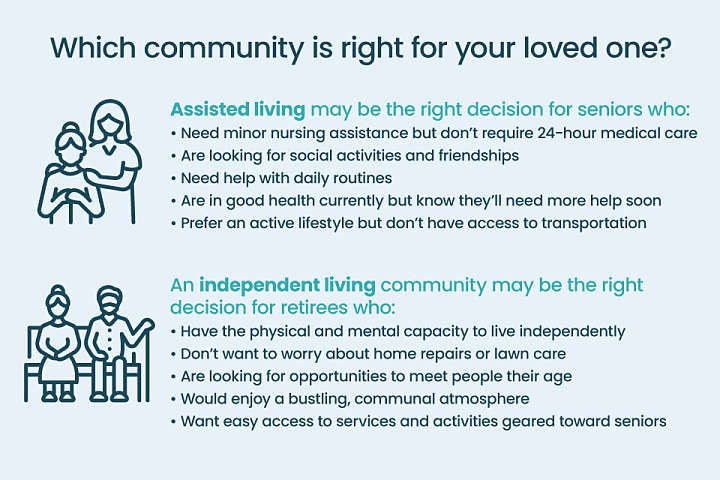You’ve made the decision to start exploring your options for retirement living. Beyond location preferences, making your move to a new community requires your investigation into a number of factors. Especially if you have been living in your current residence for many years, just the prospect of moving itself can be daunting, not to mention the potential ways in which daily life may evolve. Whether it’s your desire to downsize, change locations, increase care access, or be a part of a 55+ community, a reasonable starting point in thinking about life after retirement or as an older adult is the consideration of whether independent living or assisted living is right for you.
As you are thinking about a transition to a retirement community, the following comparison provides some of the similarities and differences between independent living and assisted living communities. Even though retirement living may be designated as independent or assisted, resources, layouts, and amenities, not to mention cost, may vary. Additionally, some retirement communities, like that of Arbors of Hop Brook, offer multiple lifestyle and support experiences across a “continuum of care,” which includes independent and assisted living experiences as well as ongoing, long-term care. To ensure that you choose the retirement living option that best serves your lifestyle and health needs, consider the top 5 distinguishing characteristics of each type of living, as well as the similarities and differences between the two.
Top 5 Defining Factors for Each Type of Living
This graphic published by A Place for Mom, a network of senior living advisors, highlights the top 5 considerations to help you evaluate whether an independent living or assisted living community is the right fit for you or your loved one.
 Since you are probably in the initial stages of exploring various living options, be aware that there are also different types of living situations within each of these two categories. Additionally, a variety of factors including location, level of luxury or care, and residential design, to name a few, influence the resources and offerings of each senior living model.
Since you are probably in the initial stages of exploring various living options, be aware that there are also different types of living situations within each of these two categories. Additionally, a variety of factors including location, level of luxury or care, and residential design, to name a few, influence the resources and offerings of each senior living model.
Key Similarities Between Assisted and Independent Living
Residents in both independent and assisted living communities value the social life, security, amenities, and dining services that are some shared features of these retirement options.

Social Events and Activities
From game or movie nights in communal spaces to shopping trips and scheduled cultural outings, looking at the community event calendar shows how many opportunities there are to socialize in house and in the surrounding area. Depending on the living community and apartment layout, personal residences or main buildings may support special visitors for overnight stays or week day lunches in a private dining space.
Security
In both living models, security takes a variety of forms. Whether it’s the availability of 24 hour emergency service, on site generators, and ongoing health monitoring or locked mailboxes, storage units, and round-the-clock security screening and personnel, confidence in the safety of one’s possessions, space, and health is paramount. A sense of security may also be more personal in nature, as with the comfort of regular beauty treatments, transportation access, or even personal gardening opportunities on the property.
Amenities
For many, an essential amenity of retirement living is the maintenance of the property itself. Inviting offerings frequently include general property upkeep, such as appliance repair and routine facility services, trash disposal, and snow removal from residents’ vehicles, not to mention the availability of freshly prepared meals, routine cleaning, and laundry services. Additional amenities, like on site beauty salons, art or yoga studios, and game or movie rooms, also tend to be featured in either living community.
Food and Dining
Depending on the care needs of individuals in each living scenario, dining accessibility is important. Options span the food service spectrum and potentially include room service, shared spaces for social dining, access to prepared meals, and individual meal preparation in the kitchen of one’s own residence. Many people appreciate being able to make a cup of coffee or favorite soup in their own space but enjoy a meal with others, if they choose.
Notable Differences Between Independent and Assisted Living
Since care needs vary so significantly from one individual to the other, some of the features in the similarities section above may be more or less accessible, especially as the needs of the community member evolves. However, there are some notable differences between independent and assisted living to consider when determining the level of support that best suits both current and future health considerations. After all, additional needs may or may not arise over the years, but if care needs increase, consider whether or not you’ll want to move again during that period of your life.
 Care Services
Care Services
From daily wellness check-ins to personal cleaning and clothing assistance to medication management, assisted living care provides services to support residents’ wellness needs on a spiritual or social level, as well as those associated with their physical and emotional health. In some cases, the necessary support is help with mobility or transportation; in others, ongoing rehabilitation and recovery may be the focus. In independent living, community members may have access to nursing staff or transportation getting to and from medical appointments, but that accessibility depends on the set-up and layout of the community and property.
Transportation
While people participating in independent living models often have access to public transportation provided by the community’s facilitators, they also typically have private vehicle access. For those individuals in assisted living, provided transportation to and from shopping excursions or appointments occurs through the site coordinator and with caregiver support. Necessary healthcare may also take place primarily on campus with on site professionals.
Residential Layouts
Residential layouts in assisted living set-ups tend to be smaller and more localized around shared communal, dining, and care spaces. Housing in independent living scenarios tends to offer greater variety in room layouts and privacy and include more specialized rooms, like kitchens, pantries, and laundry spaces, as well as related in house appliances, which may be community property or come from previously owned residences.
Cost
Finally, due to the greater care needs associated with assisted living, residing in this type of community is often accompanied by a comparable cost increase. That said, in both independent living and assisted living scenarios, it is often possible to increase or decrease services or spatial requirements and their associated costs based on the resident’s needs.
From retirement homes to assisted living facilities to continuing care retirement communities, like Arbors of Hop Brook, the considerations for your next home may seem overwhelming, and it may be hard to distinguish which choice works best for you, when so many features may seem similar. To translate the wishlist for your retirement residence into reality, it can be helpful to take a virtual tour or schedule a tour at a continuing care community, like Arbors of Hop Brook, that offers a comprehensive spectrum of options from independent living and assisted living to skilled nursing care and memory care.


